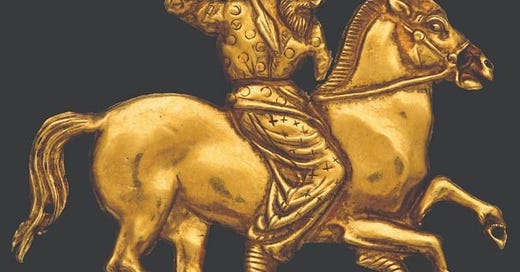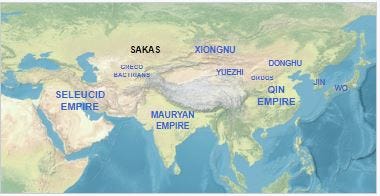Rise of Japheth
“The sons of Japheth were Gomer and Magog and Madai and Javan and Tubal, and Meshech and Tiras. And the sons of Gomer were Ashkenaz and Riphath and Togarmah. And the sons of Javan were Elishah and Tarshish, Kittim, and Dodanim.” -Genesis 10:2-4
Looking at the meaning of the name Japheth, in Hebrew the term may come from the root “יפה” (y-p-h) meaning beauty, but also equally as likely is the Aramaic root “פתה” (p-t-h) meaning “to extend”. According to Rashi, the latter is more likely and would fit with the Torah claiming that Japheth would end up the most numerous of the brothers.
While in the previous section we mentioned Japheth as “the elder” brother this is actually a misnomer based on an ambiguous reading of Genesis 9:24 which states “brother of Japheth, the elder” in reference to Shem. The line could either be read that Japheth was the elder, or Shem, but what is clear is Ham as the middle child. The ordering of the names implies that Shem, followed by Ham, and then finally Japheth was the correct sequence, but there are later lines that imply Japheth was the “main” brother. It could be that he was the main brother, but still the youngest. In those days age was viewed as seniority and it’s unlikely an older brother would “dwell in the tents” of a younger brother - as the Torah says Japheth will do with Shem. The implication here is that Japheth is the younger brother.
In order to unravel the picture of who Japheth would be historically, we must first begin with his children due to Japheth's life, and therefore political history, coming prior to the flood. Much of Japheth’s lineage plays a minor role in biblical Jewish geopolitics when compared with that of Ham and Shem. However, as we will see Japheth and his lineage actually represent the vast majority of the world's population and major empires.
Gomer
Starting with Gomer, the likely etymological descendants who bear his name would be the “Cimmerians”, a nomadic Iranian nation called “Gimmerai” in Assyrian records. The C in Cimmerian should therefore be pronounced closer to “Gimmer”, giving us the form of the name “Gomer” in the Torah. In the Book of Ezekiel 38:6, Gomer is identified as an ally of his brother Magog, and tractate Yoma 10a in the Talmud identifies Gomer with “Germamya”, or Germany as we would know them today. It is important to note that modern “Germany” is separate from the more ancient identity of “Germanic”, which compromises a much wider swath of nations than Germany proper.
However, based on archaeological finds, Gomerians - or in this case “Cimmerians” - are not limited to Germany, and like many steppe nomads find themselves in remote corners of the globe. Finds from sites spread as far as Germany and Russia are identified as Cimmero-Thracian, supporting a cultural ethno-genesis of these two peoples in the region.
There was even a Germanic tribe during the Roman times on the river Rhine named “Sicambri” but in this period “Germanic” was mostly used as a catch all for inter-mingled Germanic, Celtic, Cimmerian and beyond. Indeed many of the names of these Sicambri have Celtic suffixes for example the eponymous ‘-rix’ known from one of Rome most infamous enemies, Vercingetorix (pronounced “Vehrsin-jeh-tohrix”). Many of these Cimbri settle on the peninsula of Jutland, on the border of Denmark and Germany. Some of these Jutland settlers make their way to England, possibly explaining the origin of the ethnonym “Cymri”, the native name used by the Welsh. Even today in Italy there is a small population of around 400 “Cimbrians”1 speaking a pseudo-Bavarian - a german language - in the heartland of Italia. There are celtic rumblings in the form of both genetics and names that hint these “Germans” might have some relation to the Cimbrian Germans of Roman records.
We can clearly see some potential connection between Cimmerians, Celts and Germans, but they are all likely separate from one another and merely come from a common ancestor, in this case potentially Gomer, but more likely a shared ancestry with Japheth is the real link between these people making their connection more ancient despite contemporary contact and inter mixing.
Keeping in mind these people were highly nomadic and mobile, the actual ethnic and cultural units of these groups is extremely unclear. We will turn our attention to ancient records contemporary with the Cimmerians for possible candidates for Gomer.
In addition to the previous connections between Cimmerians, Celts and Germanics, another group of Cimmerians are said to have invaded Assyria, through Urartu, likely over the Caucasus mountains. One group of Cimmerians went west2, settling for a time in Anatolia after suffering a defeat by the Assyrians, and another group moved east, toward Georgia.3 Assyrians called their land “mat Gimiriya” which translates simply to “land of the Gimir” offering no clues to its location due to their nomadic habits. Interestingly we find that in Armenian records there is a region in Cappadocia, Anatolia known as “Gamir”, strikingly similar to the “Gimmerai”, or Cimmerians. In Georgia as well we find evidence in Mesopotamian sources for a group of Cimmerians around the Kuros river in a region also called “Gamir”.4 Due to the multiple “lands” associated with Gimir, or Gomer, is it clear these are unlikely to be the original homeland of the Cimmerians. What these clues certify is that Cimmerians form the basis of many groups, and it’s likely the term “Cimer” or “Gimer” is a much older word.
A potential origin for the term might be in the Cimmerian Old Iranian language where the word “Gayamira” means a union of clans.5 A similar Old Iranian term “Gamira” also means “mobile unit” sharing a root with the previous word.6 Both of these words help show that “Cimmer” - pronounced originally with a hard “K”, morphing from the original “G” - is likely a term that refers to a unity of diverse ethnicities, and cultures. Gomer in the bible having three sons would support this theory.
In later periods these ‘Eastern Cimmerians’ would come to be known by the name “Saka” while traveling with their close allies the Scythians. They would come to play a critical role in the politics of Transoxiana, India, and even China. While tenuous, there is a possibility that the “Shakya” clan of India come from the Saka. This clan is famously known as the clan of Gautama Buddha, with Buddhism being heavily influenced by Hellenism following the rise of the Indo-Greek Kingdoms. We find an assimilation of Scythian and Saka-Cimmerians inside the Indo-Greek Kingdom, leading credence to a distant connection between these interrelated peoples. Furthermore after the dissolution of the Indo-Greeks, we get the rise of Indo-Saka which dominated northern India for over 500 years.
Furthermore scholarly consensus presumes the Saka of both of these Kingdoms spoke a form of Scythian firmly placing Scythian languages as the dominant family across the steppe region, and the language of the Cimmerians. During later periods the term Scythian and Saka are used to refer to anyone from this Scythian-Siberian steppe - known as the Eurasian Steppe - including Turks, Goths, Huns, Avars, and Khazars. This also helps link the wider “Indo-European” groups showing a regional bridge in the form of the Eurasian Steppe. In later periods this entire region was “Turkified”, and subsumed inside a Turkic ethnic identity that replaced the Scythian culture.
According to Achaemenid Persian records the Saka even had three identities, and were not a single tribe. Saka “beyond the sea”, a likely reference to the West Saka across the Pontic, Saka who “wear pointed caps” a clear visual mention of the Massagaetae, and a third reference to Saka who “lay Hauma”. This ‘Hauma’ is known as the ‘divine plant’ in the Zoroastrian religion - the main religion of the Iranian/Persian peoples - and would be similar in context to the Vedic drink Soma; implying these references are to the Indo-Scythian kingdoms. Essentially these people form the basis of “Hindu” traditions and much of modern India’s religious structure comes from these peoples migration to the subcontinent.
The smoking gun for the Scythian-Saka theory of Gomer is found in the Assyrian term for the Schythian-Saka: “Ashkuzaya”, a clear reference to the Ashkenaz, Gomer’s first son. This term is likely rooted in the Indo-European word for “(s)kewd”, meaning “shoot” which is even the origin for the English term. These “skewdiya”, or “a-skewdiya” would be steppe horse archers, similar to the ones found in later periods to dominate the nomadic steppe hunter culture. Alternatively the essence of this term could be viewed as a portmanteau of “Scyth-Saka”, or “(A)shku-zaya”. The question turns to “who are these Scythian-Sakas?”
In order to keep this post from being too long, I will be splitting the next section dealing with similar subject matters for the next post. Thank you for reading, I hope readers are able to learn some new things and deepen their connection to the primary text. The next post will deal with the Scythians and their connection to Gomer.
I must mention they go by the name “Zimbar” because Zimbar sounds fantastic.
Diakonoff 1985, p. 93.
Barnett 1982, p. 355
Harmatta, János (1996). "10.4.1. The Scythians".
Diakonoff, I. M. (1985). "Media". In Gershevitch, Ilya (ed.). The Cambridge History of Iran. Vol. 2. Cambridge, United Kingdom: Cambridge University Press. p. 36-148









